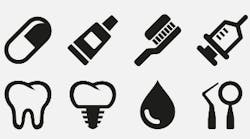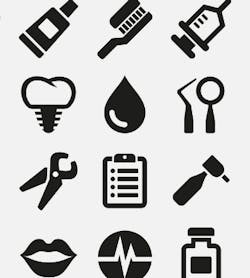4 practical strategies to control dental supply costs
Keeping supply costs in your dental practice reasonable can help your bottom line flourish. But that's often easier said than done. Here are some practical guidelines to keep your supply costs consistently within reason.
___________________________________________________________________________________________________
This article originally appeared in the Principles of Practice Management e-newsletter. Subscribe to this informative twice monthly practice management ENL here.
When you consider THE AVERAGE DENTAL PRACTICE SPENDS 6% TO 6.5% OF ITS TOTAL EXPENSE BUDGET ON SUPPLIES, it may seem like a small percentage. But it’s surprising how quickly that percentage can creep into the double digits and impact the bottom line of a practice. Effectively managing your practice supplies reduces waste, lowers costs, and increases profitability. Whether your practice is small, medium, or large, getting the best prices for quality supplies can be challenging.
Here are four practical strategies to help you manage practice supplies and negotiate the best prices.
1. Understand the 80-20 rule
The 80-20 rule is an economic principle that says 80% of outcomes result from 20% of causes. This rule, also known as the Pareto principle, helps a business allocate the necessary resources to its most important factors. So, how does this principle apply to dental practices? Simply put, dentists use 20% of all purchased dental supplies 80% of the time.
For a general dentistry practice, those supplies can include cements, composites, impression materials, and anesthetics. When you build a formulary based on the frequency of practice procedures, it reduces waste, limits supply variations, and builds purchase power. Limiting supply selection to one or two options helps build volume and lower unit price. For infrequently performed procedures, it doesn’t make sense to purchase the required supplies in volume. To streamline supply orders and optimize volume discounts, you need to review prior years’ supply orders and inventories thoroughly to identify overages, underages, or usage changes.
2. Establish a regular review process
After you build a formulary based on the 80-20 rule, it’s time to integrate a monthly or quarterly review process to identify issues and make appropriate adjustments. Inevitably there will be fluctuations or changes during any given quarter due to patient needs, staff changes, compliance requirements, or technology. With a regular review process in place, you are better able to fine tune supply needs and control spending. Think of it as a built-in due diligence system that helps you manage supply inventories and orders. It also helps eliminate redundancy, reduce waste, and increase purchase power.
3. Try before you buy
Build sample requests into your regular review process, either from distributors or manufacturers, to “try before you buy” new products. Include new products in the market or supplies you are interested in testing against brands you currently use. Always be selective about any products you decide to add. Ask yourself whether it is a “need to have or nice to have” supply. When testing new supplies, get staff involved in the test, evaluation, and feedback process. Both you and your team are “stakeholders” in the evaluation process. Bottom line, any supply change or new addition should have both clinical and financial benefits for the practice.
4. Renegotiate supply contracts every year
It typically takes 12 months of purchasing supplies and using these strategies to realize reduced expenditures and savings. Buying power comes from your ability to manage practice supply inventories efficiently. When you have buying power, you have the leverage to negotiate price and terms. Every year, ask current distributors and vendors for new price quotes based on your supply list and history. A reputable distributor will value your business and work with you to identify cost saving opportunities. If a distributor is reluctant to work with you or help manage your spending, consider conducting a bid. Bidding your supply business allows distributors to be competitive, which in turn gives you the best supply pricing for your practice. Bottom line, the less you spend on supplies, the more profitable your practice becomes.
Patience pays off
As with anything new, it takes time to initiate the process, establish a routine, and see results. Sure, it will take time and effort, not to mention some growing pains, to successfully integrate these strategies into your practice. But don’t despair. Work with your team to create a supply management process based on these four strategies in a way that best works for your practice. Make adjustments and enhancements along the way, but these four strategies are the foundations to managing dental supplies and reducing overall spending successfully.


